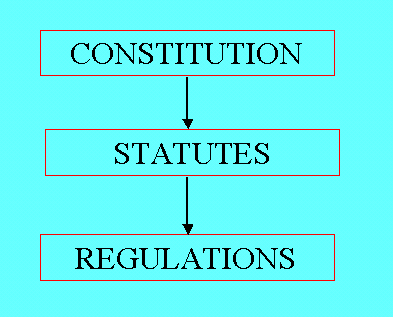
Law overview.
This submodule will explain a little of the legal environment in which environmental laws exist and introduce a few important legal terms.
( Civics 101. For our international students and U.S. student's who were playing
ball the day this was taught in high school.)
The U.S. has a written constitution that establishes our federal government,
provides a framework for our laws, and also the mechanism for changing that
constitution. The states existed prior to the constitution and were more or
less independent of each other; the constitution provided for new states to
be admitted to the union. The constitution establishes three separate branches
of the government: the executive (the president, the federal bureaucracy, the
military), the congress (house and senate) and the courts (supreme and lower
courts.) The constitution gave to the federal government certain powers: military,
foreign policy, currency, regulation of interstate commence, and a few others.
But all powers not specifically mentioned remained with the states.
Briefly, the congress makes the laws, the executive enforces the laws, and the courts interpret the laws. Most states have similar constitutions and division of government into branches. While the U.S. constitution's separation of powers is not unique among nations, the parliamentary organization is more common worldwide. The leading party in the parliament appoints one of its own as "prime minister" and other ministers who enforce the laws and run the bureaucracy and there is no clear separation of powers between the law-making and law-enforcing branches of government. Most nations have some mechanisms for keeping their courts somewhat independent, at least in theory, of the party in power, but many of these provide for an appeal of the highest court's decision back to parliament, again somewhat blurring the separation of powers in those countries.
While our law making-law enforcing scheme is simple for something such as making Monday a holiday, it is not useful for complex technical matters. For example, deciding whether it is safe to drink water with 50 ug/L of arsenic or if the limit should be 10 ug/L. Congress has neither the time nor technical expertise to deal with scientific and technical matters. What the congress does is pass a law (called a "statute.") that says the level of contaminants (arsenic and hundreds of others) shall be low enough such that "human health shall not be impaired." Then congress further authorizes an agency of the executive branch to "promulgate regulations" to carry out the intent of the law.

So the constitution provides the overall framework of our government and laws, but it was written and amended by a complex process that is designed to discourage changes to it. Federal laws, known as "statutes" are made by:
Who promulgates regulations
The regulations are "the law" too, we sometimes refer to them as "administrative law" if it is necessary to distinguish them from the underlying statutes.